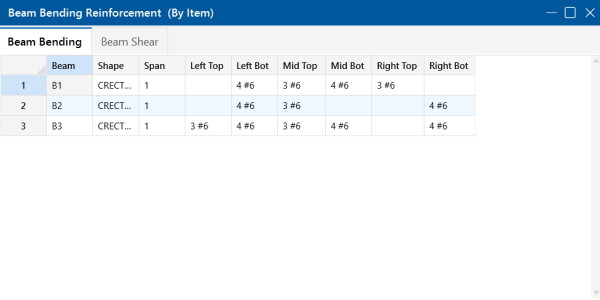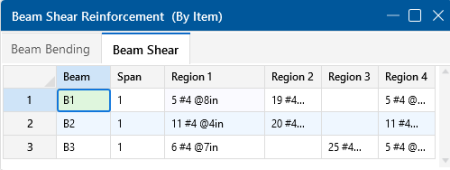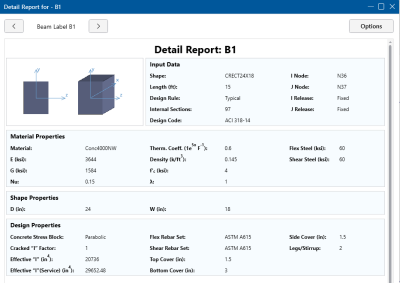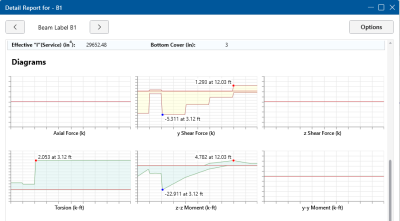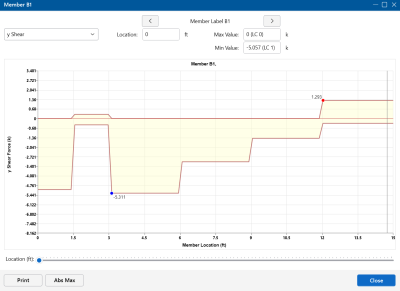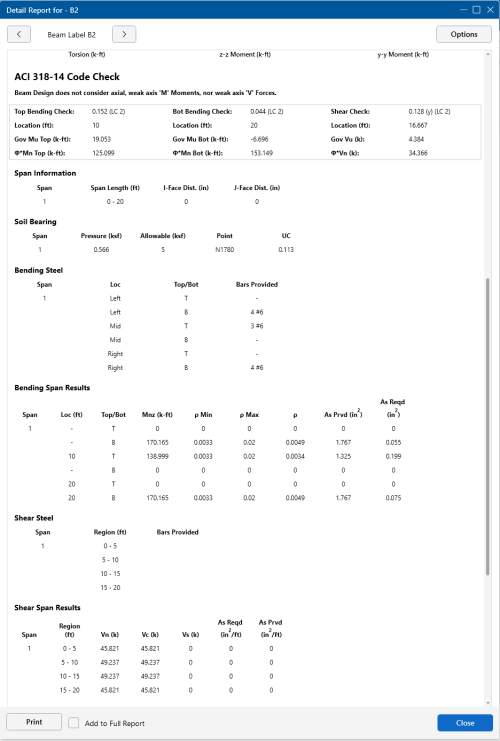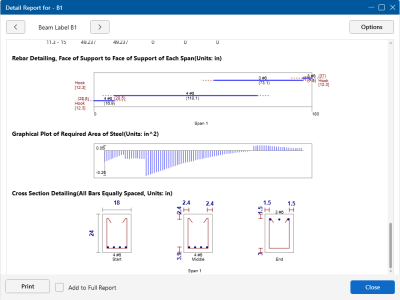Beams - Design Results
Access the Beam Design Results Spreadsheet
by selecting the Results tab  Results Browser button
Results Browser button  Beam Code Check. Alternatively, you can select Beam Code Check from the Explorer Panel. Note that concrete results are always based
on envelope results.
Beam Code Check. Alternatively, you can select Beam Code Check from the Explorer Panel. Note that concrete results are always based
on envelope results.
For beam flexural design, the required bars are based on the envelope moment diagrams. Similarly, the required bars for beam shear steel design are based on the enveloped shear force diagrams.
Beam Results
Beam results are shown in the following spreadsheets: Beam Design Results and Beam Reinforcement.
Beam Design Results Spreadsheet
The Beam Design Results Spreadsheet shows the governing maximum code check for the top and bottom of the beam for all spans.
Click on image to enlarge it
These top and bottom code checks, UC Max Top and UC Max Bot, are based on the top/bottom moment capacities and maximum top/bottom moment. Currently, the moment capacity is only based on the tension steel (NO compression steel is considered in the capacity calculation). The governing maximum shear check for all spans, Shear UC, is also shown. The capacities shown are only for the governing section. Capacities for each span, as well as beam reinforcement detailing diagrams, may be viewed in the Detail Report.
Beam Bending Reinforcement Spreadsheet
The Beam Bending Reinforcement Spreadsheet records the top and bottom flexural reinforcement steel required for the left, middle and right locations of each beam. This spreadsheet may be accessed by selecting Beam Reinforcement from the Results Menu. Results are listed on the Beam Bending tab.
Click on image to enlarge it
The Beam column lists the beam label.
The Shape column displays the beam size.
The Span column displays the span number corresponding to the reinforcement sections listed. Span '1' is the span beginning at the "start" of the beam and subsequent spans are numbered '2', '3', '4' and so forth moving from the "start" to the "end" of the beam.
The program assumes that the moment diagrams for all beam spans have two or fewer points of inflection. Therefore, each span is broken into Left, Middle and Right Reinforcement Sections for flexural steel layout. Each section is further broken into Top and Bottom Reinforcement Sections. Note that a beam may only have two, or even one, reinforcement section. In this case, the other reinforcement sections would be left blank in this spreadsheet.
The Left Top, Left Bot, Mid Top, Mid Bot, Right Top and Right Bot entries record the number and size of flexural reinforcement bars that are required in each of the six Reinforcement Sections. The first number indicates the number of parallel reinforcement bars in that section. The second number, preceded by the '#' sign, indicates the size of reinforcement bars used.
- Only reinforcement bars selected by the program are listed in this spreadsheet. If a custom rebar layout is used for a particular beam, all six reinforcement section entries will report "CUSTOM" as a reminder that the user applied a custom rebar layout.
- Longitudinal reinforcement bars are assumed to be in a single layer at the top and/or bottom of the member.
- Longitudinal reinforcement bars for the left and right sides of adjacent spans have been "smoothed" such that the larger steel area is used for both sides.
Beam Shear Reinforcement Spreadsheet
The Beam Shear Reinforcement Spreadsheet records the shear reinforcement ties required in each shear region of each beam. This spreadsheet may be accessed by selecting Beam Reinforcement from the Results Menu. Results are listed on the Beam Shear tab.
Click on image to enlarge it
The Beam column lists the beam label.
The Span column displays the span number corresponding to the shear regions listed. Span '1' is the span beginning at the "start" of the beam and subsequent spans are numbered '2', '3', '4' and so forth moving from the "start" to the "end" of the beam.
Each beam's shear reinforcement layout is broken into either two or four Shear Reinforcement Regions. The user can control whether the program uses '2' or '4' regions from the Rebar tab of the Model Settings Dialog. The program will try to group the required shear ties/stirrups into two or four regions and will allow for a middle region to have no shear reinforcement if the shear force is lower than the force at which code required reinforcement must be provided.
The Region 1, Region 2, Region 3 and Region 4 entries record the number, size and spacing of shear reinforcement ties/stirrups that are required in each of the Reinforcement Regions. The first number of each entry indicates the total number of ties/stirrups that are required in that region of the beam span. The second number, preceded by the '#' sign, indicates the size of reinforcement bars used. The third number, proceeded by the "@" symbol, indicates the spacing of the ties/stirrups in that region of the beam span.
- If '2' shear regions are selected on the Design tab of the Model Settings Dialog, the Region 2 and Region 3 entries will be left blank in this spreadsheet.
- The concrete code checks are only performed at the sections where the internal forces are calculated. The number of internal force calculations is based on the setting in the Model Settings dialog. Normally, this is acceptable for design and analysis. However, it is possible for the design locations (face of support for moment and "d" from the face of support for shear) to be located far enough away from the nearest internal force location that it could affect the code check results. If this happens, it may be advisable to use a larger number of internal sections. Or, the user may be forced to calculate the maximum Vu and Mu themselves.
Beam Detail Reports
The Beam Detail Reports allow you to see the overall force state for any particular beam. Detail reports for concrete beams are not based on individual load combinations; instead, they are based on an envelope of the solved load combinations.
Detail reports for concrete beams can, and often do, exceed one page in length due to the large amount of information that must be displayed for concrete design. One reason for this is that RISAFoundation determines the number of spans for concrete beams based on the number of internal supports. Thus, one physical member may have several spans that all must be reported.
The image below is the first portion of a detail report for a concrete beam showing the member information.
Click on image to enlarge it
You can identify the Member Type by referring to the text between the navigation arrows in the upper-left corner of the Detail Report dialog window. This title will always show the member type (Beam).
The Member Information in the text above the force diagrams displays basic member information, as well as the Concrete Stress Block type used in the solution.
The next section of the detail report contains the Member Force Diagrams. The diagrams shown are envelope diagrams of all solved load combinations. Any Unused Force Warnings or critical Design Warnings will be shown directly below the force diagrams in the detail report. An enlarged interactive member force diagram can be accessed by clicking on the desired diagram.
Click on image to enlarge it
Click on image to enlarge it
Each enlarged diagram will also have a slider bar at the bottom of the window for checking forces at all locations along the member. There is also an Abs Max button that will jump the slider bar to the absolute maximum value in the diagram. Note that once an enlarged diagram is opened, diagrams for other forces may be accessed via the drop-down menu on the left.
The Code Check Information, directly below the force diagrams, is a summary of the governing checks for bending and shear, their location and the section capacities at those locations. Separate bending checks for the most critical top and most critical bottom condition are provided. Gov Mu Top and Gov Mu Bot represent the governing ultimate moment in the top and bottom of the beam, respectively. Gov Vu represents the governing ultimate shear along the local y-axis of the beam.
The values phi*Mn Top and phi*Mn Bot represent the nominal moment strength at the top and bottom of the beam respectively, reduced by the appropriate Strength Reduction Factor, Phi, as indicated in the code. Likewise, the value phi*Vn represents the nominal shear strength in the beam, reduced by the appropriate Phi Factor.
General concrete, reinforcement and bar cover information about the section is also provided, which you would need if you were doing a hand check. Concrete Type (Normal Weight vs Light Weight) is automatically determined from the Concrete Weight density per the ACI code. λ is taken from the Materials spreadsheet. The E_Concrete value shown here is either the value entered on the Materials Spreadsheet or the calculated value based on the given f’c and weight density (if the 'E' value was left blank on the Materials Spreadsheet).
The Span Information gives the start and end of each span centerline within the member, as well as the distance from the support centerline to the face of the support for each end of the span.
The next portion of the detail report, shown below, contains detailed information for the placement of the Bending Steel and Bending Span Results for each span. The bending capacity for the governing section in each span is shown as Mnz, the nominal moment strength. Rho Min and Rho Max are the minimum and maximum required reinforcement ratios at each location. These values are based on the minimum and maximum reinforcing requirements for flexural members, as described in ACI 318-14 Sections 9.6.1 and 21.2.2/9.3.3.1, respectively (ACI 318-11 Sections 10.5.1 and 10.3.3/10.3.5, respectively). Rho is the ratio of reinforcement corresponding to the area of steel provided at each location, As Prvd. The As Reqd value is the area of steel required at each location.
Click on image to enlarge it
The next portion of the detail report (also shown above) contains detailed information for the placement of the Shear Steel and the Shear Span Results for each span. Shear results are shown by region, within each span. The number of regions used is a function of the shear diagram, with the maximum number of regions taken from the Shear Regions setting on the Design tab of the Model Settings Dialog. The number, size and spacing of reinforcing bars is provided for each region. Also indicated is the nominal shear strength, Vn, in each region. The portion of the nominal shear strength provided by the concrete and the steel, Vc and Vs respectively, is given for each region. The area of steel required, As Reqd, and the area of steel provided, As Prvd, are also given for each shear region and are reported as 'area of steel per unit dimension', i.e. in2/in or mm2/mm.
It should be noted that the values for Mn and Vn in this section of the detail report are the UNREDUCED nominal capacities of the member at each span/region. The actual design capacities would be obtained by multiplying these values by their respective Phi Factors indicated in the code.
The last section of the detail report, shown below, displays the Beam Reinforcement Detailing Diagrams. The Rebar Detailing portion of the report displays elevation views of the beam, complete with top and bottom flexural reinforcement indicated for the left, middle and right portions of each span. The number and size of bars required in each section is indicated on the top middle of each drawn bar. The required length of each bar is indicated on the bottom middle of each drawn bar in parenthesis. Development lengths are shown in parenthesis at one end of each bar and represented by a dashed line. In addition to the development lengths, hook lengths are provided for bars at the ends of the beam, shown in brackets.
The values shown at the bottom corner of each span indicate the distance from the start of the beam to the face of a support. Flexural bars at the ends of the beam are measured beginning at the face of the support and bars at intermediate supports are measured to the center of the support.
The number, size and spacing of shear reinforcement is also indicated below each span in the corresponding shear region. Each shear region is indicated by vertical lines at the bottom of the beam.
Click on image to enlarge it
The Cross Section Detailing portion of the report shows cross sectional views for the start, middle and end of each beam span. The number and size of flexural bars for each cross section are shown, as well as the orientation of the shear ties/stirrups. The clear cover to each stirrup for the top and sides is shown. The overall beam dimensions for each span are indicated on the 'Start' cross section.

